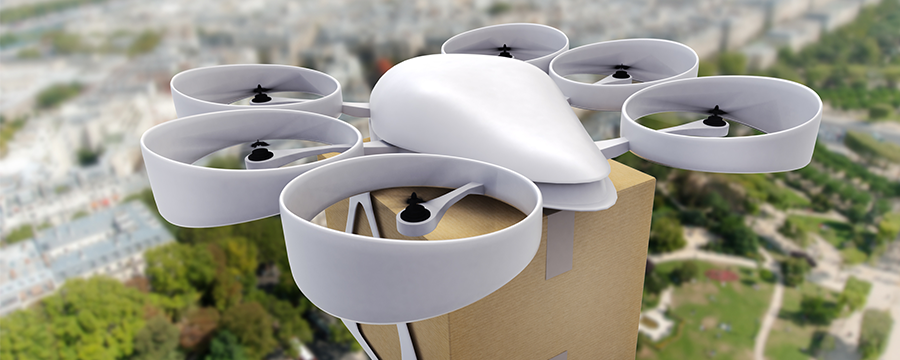- More Americans like the concept of drone delivery than dislike it, but a large number have yet to decide.
- Drone malfunction is the public’s primary concern — far more than fears about intentional misuse.
- Exposure to information about drone delivery correlates with greater interest in the idea.
- The American public anticipates that drone delivery will be offered within the next 5 to 10 years.
October 11, 2016 (RARC-WP-17-001) The national conversation about drone delivery began in December 2013 when Jeff Bezos told the world that Amazon was experimenting with drones as an alternative to traditional delivery methods. In a 60 Minutes interview, Mr. Bezos predicted that, although the technology was still 4 to 5 years away, someday the skies would be filled with an army of flying machines zipping back and forth between warehouses and people’s homes. The public reacted with astonishment, leaving some convinced that the idea represented the future of delivery, while others felt that the idea was simply a marketing stunt. Many were concerned about the implications of these airborne automatons.

Today, organizations in the United States and worldwide are bringing this once mind-bending prospect closer to reality by actively developing and testing drone delivery systems. Drones have the potential to offer substantial cost savings to deliverers while also drastically improving consumers’ ecommerce experience by offering extraordinarily fast delivery at any time of day to wherever a person is physically located — not just their home address. At the same time, filling the sky with merchandise-laden robots is a proposition that raises alarm for many citizens, including those who anticipate never benefitting from the service firsthand.
If the U.S. Postal Service intends to consider the option of incorporating drones into its operations, tracking the public’s rapidly evolving perception of this new mode of delivery will be essential to shaping the groundwork of the Postal Service’s strategy. Though it will still take a few years for the technology to mature and the regulatory framework to emerge, proactively examining the concept could allow the Postal Service to better assess its operational feasibility, fundamental economics, regulatory compliance, and social implications.
In order to understand the current state of public opinion on drone delivery, the U.S. Postal Service Office of Inspector General (OIG) administered an online survey targeting a nationally representative sample of 18-75 year-old residents in all 50 states and the District of Columbia in June 2016. Topics covered by the survey included the overall appeal of drone technology, its most and least interesting applications, the believability of claims about its potential benefits, the public’s expected timeframe for implementation, potential concerns, and how the public would view drone delivery if it were offered by five prominent players in the logistics and technology fields.1 The survey methodology and results were developed and executed internally by OIG. External review was then provided by an expert on survey research methodologies.
Analysis of the survey results yielded several key findings, including
■ Drones are on the horizon: The American public anticipates that drone delivery will be offered within the next 5 to 10 years.
■ An ambiguous reception: More Americans like the concept of drone delivery than dislike it, but a large number have yet to decide.
■ Americans do not yet trust drone technology: Drone malfunction is the public’s primary concern — far more than fears about intentional misuse.
■ Different groups have notably different perspectives: Different age groups, genders, important postal customer groups, geographic regions, and residents of urban, suburban, and rural areas all display differing levels of interest in drone delivery.
■ Knowledge drives enthusiasm: Exposure to information about drone delivery correlates with greater interest in the idea.
■ Speedy delivery piques the public’s interest: 1-hour delivery is the public’s most interesting application, and delivery speed is the technology’s most believable benefit. Emergency delivery also garners interest.
■ Too soon to launch: It may be too soon for any organization to offer drone delivery, as offering the service now leads to a drag on overall brand positivity.
■ Drone Delivery could improve the Postal Service’s ratings as an innovative company: Despite its drag on overall brand positivity, association with drone delivery makes the Postal Service look more innovative.
This paper, which employs an approach that is common in survey and market research, begins with an overview of the survey’s methodology, as well as a summary of key findings and detailed data for the national sample. Next, five separate sections will focus on the differences in opinion that emerged among several key subgroups, like gaps between the residents of urban, suburban, and rural areas, or differences between how men and women feel about the concept of drone delivery. The report then concludes with appendices that provide additional details about the survey methodology and the full text of the survey’s questionnaire.
Click here to download the USPS OIG full report